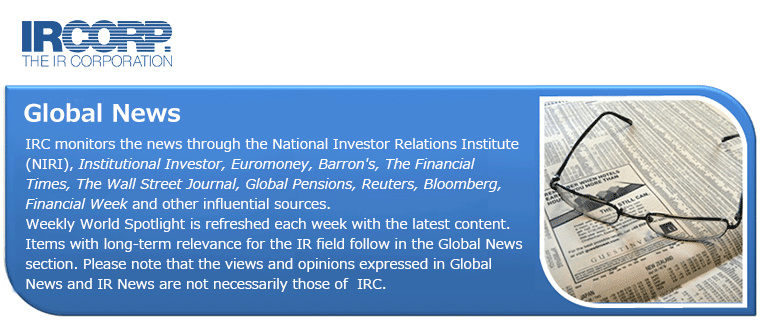Wall Street Journal (June 15)
“Despite some CEO grumbling, businesses have thrived under Biden. Stocks are near records, corporate profits are up strongly, inflation has come down and the economy has so far managed a soft landing despite aggressive rate increases from the Federal Reserve. Industries like energy that appeared to be at risk from Biden’s policies have thrived.”
Tags: Biden, Businesses, CEO, Corporate profits, Economy, Energy, Grumbling, Inflation, Records, Soft landing Fed, Stocks, Thrived
Washington Post (June 4)
“The European Central Bank on Thursday is almost certain to lower its benchmark interest rate for the first time in nearly five years. The move will come as the Federal Reserve remains on hold with plans to trim U.S. borrowing costs, amid inflation that is proving more stubborn than anticipated.” For the ECB, however, inflation appears to be “less of a problem than the weak growth outlook.”
Tags: Benchmark, Borrowing costs, ECB, Fed, Inflation, Interest rate, Lower, Outlook, Stubborn, U.S., Weak growth
Washington Post (May 28)
“Nearly everything Americans believe about the economy is wrong.” A recent poll revealed that dire “perceptions of the U.S. economy are often at odds with reality.” In fact, “the U.S. economy has been growing consistently for nearly two years, even after accounting for inflation” and is “exceeding growth expectations” across most benchmarks. “The U.S. economy has been outperforming other advanced economies. We’re also doing better than pre-pandemic forecasts had situated us by now, both in terms of gross domestic product and the number of jobs out there. This generally isn’t true elsewhere in the world.”
Tags: Benchmarks, Economy, Expectations, GDP, Growing, Inflation, Outperforming, Perceptions, Poll, Pre-pandemic, Reality, U.S., Wrong
Financial Times (May 10)
“The UK economy has exited last year’s technical recession with faster than expected growth of 0.6 per cent for the first quarter.” This beat the BoE forecast and marked the fastest quarter-on-quarter growth since 2021. Growth was “driven by a 0.7 per cent increase in services output, suggesting stronger consumer activity as inflation fell. Manufacturing output grew 1.4 per cent, driven by car production which has grown for six consecutive quarters.”
Tags: 0.6%, 2021, BOE, Car production, Consumer activity, Economy, Expected, Fastest, Forecast, Growth, Inflation, Manufacturing, Q1, Services, Technical recession, UK
Seeking Alpha (May 8)
“Sweden is following Switzerland, Hungary, and the Czech Republic in easing monetary policy for the first time since hiking cycles began in 2022, when inflation surfaced in the aftermath of the COVID pandemic.” The quarter point cut of the overnight rate by the Riksbank makes “it more likely that the ECB will also jump on the bandwagon. The shift is noteworthy to global investors as it highlights the current central bank divergence taking place across the world.”
Tags: Aftermath, Central bank, Covid, Czech Republic, Easing, ECB, Global investors, Hungary, Inflation, Monetary policy, Pandemic, Riksbank, Sweden, Switzerland
New York Times (April 12)
“More economists are paring their bets that the Fed will cut rates after the latest Consumer Price Index report.” The new consensus of “higher-for-longer inflation… has hit the U.S. housing market like a thunderbolt. Home prices and mortgage rates are climbing again, dashing hopes that financing costs would fall this year and adding another economic question that could hang over the presidential election campaign.”
Tags: CPI, Economists, Fed, Financing costs, Home prices, Housing market, Inflation, Mortgage rates, Rates, U.S.
Business Insider (March 31)
Japan’s “stock market is ripping; the Nikkei recently exceeded the all-time highs it set 34 years ago. Analysts at Goldman Sachs are telling clients there’s still more upside to be had as corporate-governance reforms and a new era of sustainable inflation take hold. The Bank of Japan this month hiked interest rates above zero for the first time since 2007, a sign of confidence in the country’s recovery.”
Tags: Analysts, BOJ, Clients, Confidence, Corporate governance, Goldman Sachs, Highs, Inflation, Interest rates, Japan, Nikkei, Reforms, Ripping, Stock market, Upside
Professional Pensions (March 27)
“Market turmoil, inflation shocks, high interest rates, and rolling geopolitical crises spurred many investors to stay on the sidelines last year” across all asset classes. “Yet investor appetite remains strong,” especially for real assets. “Globally, nearly two-thirds of investors expect to increase their allocation to real assets over the next two years, with investors in Asia most likely to add to their portfolios.”
Tags: Allocation, Appetite, Asia, Geopolitical crises, Inflation, Interest rates, Investors, Market turmoil, Real assets, Sidelines
Financial Times (March 17)
“A strange thing happened this week: calm.” U.S. data revealed higher than expected price inflation. “This time around, however, government bonds wobbled only slightly and both US and global stocks held it together around record highs.” The absence of drama indicates “interest rates are shedding their suffocating dominance over global markets, and that stocks are climbing not because they are huffing the speculative fumes of imminent and aggressive potential rate cuts but because they’re worth it.”
Tags: Calm, Dominance, Global, Government bonds, Inflation, Interest rates, Markets, Rate cuts, Record highs, Speculative, Stocks, Suffocating, U.S.
Bloomberg (March 2)
“European Central Bank officials confronting faster-than-expected inflation might also wonder if this is just the last stumble before their 2% target looms large. While the 2.6% outcome for February released on Friday — and a still-stubborn 3.1% result for the so-called core measure — present grounds for caution, the downward momentum in consumer prices is getting harder to ignore.”
Tags: 2% target, Caution, Consumer, Core measure, Downward, ECB, February, Inflation, Momentum, Outcome, Prices, Stumble


